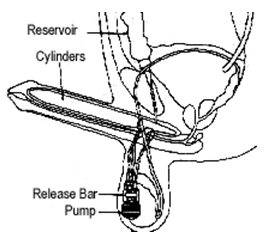Impotence (Penile Implants)A penile implant or penile prosthesis involves surgery to insert one of various types of rigid or semi-rigid forms, some with a pump, into the penis to allow erections sufficient for penetration and sexual intercourse. Penile implants require surgery and are not a method to enlarge the penis. The concept of the penile prosthesis dates back to early times when it was noticed that several species of animals had what was termed an os penis or biaculum. This is a cartilaginous support to keep the penis erect. The first penile prosthesis was actually a rib graft implanted into the corporal body. 
The recent history of penile implants dates back to 1950, when Dr. Scardino implanted the first synthetic material into the penis. Penile implants improved dramatically with subsequent work of many investigators, and penile implant surgery has progressed to a very high level. The indications for penile implant surgery include vascular disease, diabetes, bladder or prostate cancer surgery or for benign prostate disease, Peyronie's disease, neurologic disease, hypogonadism, pelvic fractures and impotence related to many medical diseases including chronic renal disease, alcoholism, multiple sclerosis, genital trauma, Parkinsonism, and drug therapy. Some of the contraindications for penile implants include poorly controlled diabetes, mostly because the patient is highly susceptible to infection, and extreme bladder outlet obstruction, because a penile prosthesis can cause a relative increase in outflow obstruction and eventually produce urinary retention. |

+91 - 95661 39630
+91 - 94441 68963



